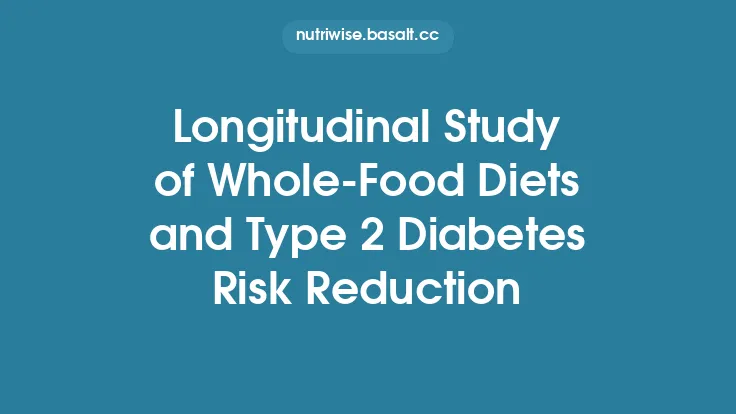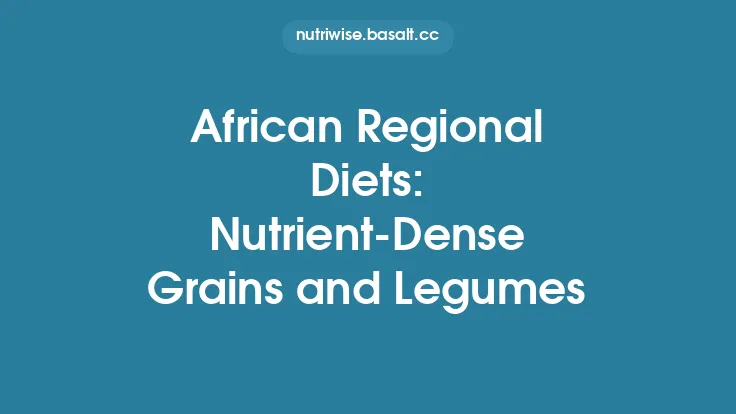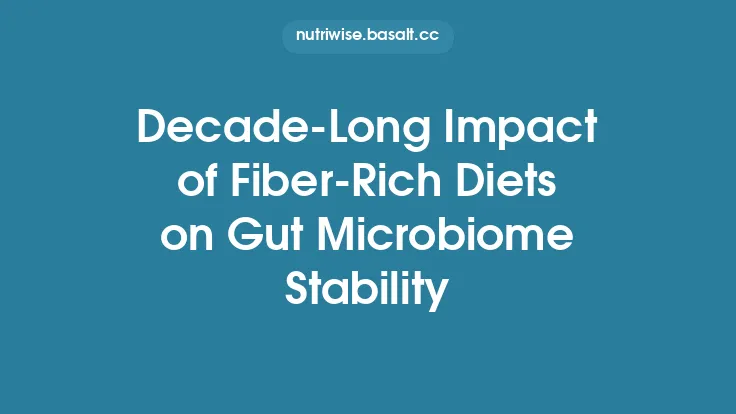The foods we eat are more than just fuel; they are a reflection of geography, climate, history, and cultural identity. Across the globe, distinct regional dietary patterns have emerged, each shaped by the availability of local resources, traditional agricultural practices, and sociocultural norms. While the specifics of these diets differ, they collectively influence the prevalence and progression of chronic diseases such as cardiovascular disease, type 2 diabetes, certain cancers, and obesity. Understanding how regional diets modulate disease risk requires a multidimensional lens that considers nutrient composition, food processing methods, lifestyle context, and underlying biological mechanisms. This article synthesizes current evidence to illuminate the ways in which diverse dietary traditions impact chronic disease risk, offering comparative insights that can inform both individual choices and public‑health policy.
Key Dietary Components and Their Biological Impact
Macronutrient Balance
- Carbohydrate quality – Regions that rely heavily on refined grains and added sugars tend to exhibit higher glycemic loads, which can provoke repeated spikes in blood glucose and insulin. Over time, this pattern contributes to insulin resistance, a central driver of type 2 diabetes and metabolic syndrome. Conversely, diets rich in whole‑grain cereals, tubers, and minimally processed starches provide slower‑digesting carbohydrates, attenuating post‑prandial glucose excursions.
- Fatty acid profile – The proportion of saturated, monounsaturated, and polyunsaturated fatty acids (PUFAs) varies dramatically across regions. Populations whose staple fats are derived from animal sources high in saturated fat often show elevated low‑density lipoprotein (LDL) cholesterol and greater atherosclerotic risk. In contrast, regions where plant‑based oils (e.g., seed or nut oils) dominate provide higher levels of omega‑6 and, where present, omega‑3 PUFAs, which can improve lipid profiles and exert anti‑inflammatory effects.
- Protein sources – Animal‑based proteins (red meat, processed meat) are associated with higher intakes of heme iron, nitrates, and advanced glycation end‑products, all linked to increased colorectal cancer risk and cardiovascular disease. Plant‑based proteins (legumes, nuts, seeds) deliver fiber, phytochemicals, and lower levels of saturated fat, offering protective benefits.
Micronutrients and Phytochemicals
- Dietary fiber – High fiber intake, common in regions where legumes, whole grains, and fibrous vegetables dominate, improves gut motility, modulates lipid absorption, and fosters a beneficial gut microbiome. Epidemiological data consistently associate fiber‑rich diets with reduced incidence of coronary heart disease and type 2 diabetes.
- Antioxidants and polyphenols – Traditional consumption of berries, herbs, spices, and fermented plant foods supplies a spectrum of polyphenols (flavonoids, anthocyanins, catechins) that scavenge reactive oxygen species, inhibit platelet aggregation, and modulate signaling pathways involved in inflammation and cell proliferation.
- Minerals (magnesium, potassium, calcium) – Diets abundant in leafy greens, nuts, and unrefined grains provide minerals that support blood pressure regulation, insulin sensitivity, and bone health. Low intake of these nutrients is a recognized risk factor for hypertension and metabolic disorders.
Regional Food Processing and Preservation Techniques
Fermentation
Many high‑latitude and tropical societies have historically relied on fermentation to extend shelf life and enhance nutrient bioavailability. Fermented dairy, vegetables, and legumes introduce live cultures that can reshape the intestinal microbiota, increase production of short‑chain fatty acids (SCFAs), and improve mucosal immunity. Evidence suggests that regular consumption of fermented foods correlates with lower markers of systemic inflammation and reduced cardiovascular risk.
Drying and Smoking
In arid or nomadic regions, drying and smoking are common preservation methods. While these techniques effectively prevent spoilage, they can also concentrate salt and introduce heterocyclic amines (HCAs) or polycyclic aromatic hydrocarbons (PAHs) when high temperatures are used. Elevated sodium intake is a well‑established driver of hypertension, and HCAs/PAHs have been implicated in carcinogenesis, particularly of the gastrointestinal tract.
Traditional Cooking Methods
- Stewing and boiling – Gentle, water‑based cooking preserves water‑soluble vitamins and reduces the formation of harmful lipid oxidation products. Populations that favor stews often have higher intakes of vegetables and legumes, contributing to lower disease risk.
- High‑heat grilling and charring – Common in regions where open‑flame cooking is culturally embedded, this method can generate advanced glycation end‑products (AGEs) and HCAs, both of which have pro‑inflammatory and pro‑oxidant properties linked to atherosclerosis and cancer.
- Oil‑rich sautéing/frying – Frequent deep‑frying in saturated or repeatedly reused oils can increase trans‑fat formation and oxidative degradation of lipids, elevating LDL oxidation and endothelial dysfunction.
Socioeconomic and Environmental Determinants of Dietary Choices
Food Accessibility and Affordability
Economic constraints shape dietary patterns more profoundly than cultural preferences alone. In low‑income rural settings, reliance on staple grains and tubers is often a necessity, limiting intake of animal protein and fresh produce. This macronutrient imbalance can predispose to micronutrient deficiencies and metabolic disease. Conversely, urbanization frequently introduces processed, energy‑dense foods that are cheap, convenient, and high in added sugars and unhealthy fats, driving obesity and related comorbidities.
Agricultural Practices and Climate
Regions with fertile soils and favorable climates can sustain diverse crop rotations, supporting a varied diet rich in fruits, vegetables, and legumes. In contrast, harsh climates (e.g., high altitude, extreme cold) restrict agricultural diversity, leading to reliance on a narrow set of crops (e.g., barley, root vegetables) and animal products. Climate‑induced shifts, such as reduced crop yields due to drought, can force dietary transitions toward imported, often more processed, foods.
Cultural Norms and Rituals
Food is central to celebrations, religious observances, and daily rituals. Certain cultural practices may encourage periodic fasting, communal feasting, or the consumption of specific ceremonial foods. Intermittent fasting traditions have been associated with improved insulin sensitivity and lipid profiles, whereas regular consumption of high‑calorie celebratory dishes can contribute to cumulative caloric excess.
Comparative Epidemiological Evidence Across Regions
Large‑scale cohort studies and meta‑analyses reveal distinct disease patterns that align with regional dietary characteristics:
- Cardiovascular disease (CVD) – Populations with diets high in whole grains, legumes, and unsaturated fats exhibit lower age‑adjusted CVD mortality. Conversely, regions where saturated animal fat and sodium‑rich preserved foods dominate show higher rates of hypertension, coronary artery disease, and stroke.
- Type 2 diabetes – High glycemic load diets, especially those reliant on refined starches and sugary beverages, correlate with increased incidence of diabetes. In contrast, diets rich in fiber, low‑glycemic index carbohydrates, and moderate protein intake are protective.
- Cancer – Elevated consumption of processed meats and salt‑preserved foods is linked to higher gastric and colorectal cancer rates. Diets abundant in cruciferous vegetables, berries, and fermented soy (where present) are associated with reduced risk of certain cancers, likely due to their antioxidant and anti‑inflammatory constituents.
- Obesity – Energy‑dense, low‑nutrient foods introduced through globalized food systems have contributed to rising obesity prevalence in many transitioning economies, regardless of traditional dietary foundations.
Mechanistic Pathways Linking Diet to Chronic Disease
- Inflammation – Diets high in saturated fat, refined carbohydrates, and trans‑fat stimulate pro‑inflammatory cytokines (IL‑6, TNF‑α) and activate the NF‑κB pathway, fostering a chronic low‑grade inflammatory state that underlies atherosclerosis and insulin resistance.
- Gut Microbiome Modulation – Fiber‑rich, polyphenol‑laden diets promote a diverse microbiota that produces SCFAs (butyrate, propionate) which improve gut barrier integrity, regulate glucose homeostasis, and modulate lipid metabolism. Dysbiosis, often seen with high‑fat, low‑fiber diets, can increase endotoxemia and systemic inflammation.
- Oxidative Stress – Excessive intake of oxidized lipids and AGEs overwhelms antioxidant defenses, leading to LDL oxidation, endothelial dysfunction, and DNA damage—key steps in CVD and carcinogenesis. Antioxidant‑rich foods counteract these processes.
- Epigenetic Influences – Nutrients such as folate, B‑vitamins, and polyphenols can modify DNA methylation and histone acetylation, influencing gene expression related to metabolism, inflammation, and cell proliferation. Regional dietary patterns thus have the potential to affect disease risk across generations.
Integrating Regional Insights into Public Health Strategies
- Tailored Nutrition Education – Messaging should respect cultural food practices while highlighting modifications that reduce disease risk (e.g., substituting saturated fats with locally available unsaturated oils, encouraging fermentation of traditional vegetables).
- Food Policy and Subsidies – Governments can incentivize production and consumption of nutrient‑dense crops (legumes, whole grains) through subsidies, reducing reliance on imported processed foods.
- Community‑Based Interventions – Engaging local leaders and leveraging existing food preparation traditions (e.g., communal stews, fermentation workshops) can facilitate sustainable dietary shifts.
- Monitoring and Surveillance – Region‑specific dietary surveys combined with health outcome data enable the identification of high‑risk patterns and the evaluation of intervention efficacy.
Future Directions and Research Gaps
- Longitudinal Multi‑Regional Cohorts – More prospective studies that follow diverse populations over decades are needed to disentangle the effects of diet from confounding lifestyle factors.
- Precision Nutrition in Traditional Contexts – Integrating genomic, metabolomic, and microbiome data with cultural dietary patterns could refine individualized recommendations without eroding cultural heritage.
- Impact of Climate Change – Investigating how shifting agricultural zones will alter regional food availability and, consequently, chronic disease epidemiology is critical for proactive public‑health planning.
- Food Processing Innovations – Developing low‑sodium, low‑AGE preservation methods that align with traditional practices could mitigate disease risk while preserving cultural authenticity.
By examining the intricate web of nutrients, preparation methods, socioeconomic forces, and biological pathways, we gain a clearer picture of how regional diets shape chronic disease trajectories. Recognizing both the protective and harmful elements embedded in cultural food traditions empowers health professionals, policymakers, and communities to craft nuanced, culturally resonant strategies that promote long‑term wellness across the globe.





